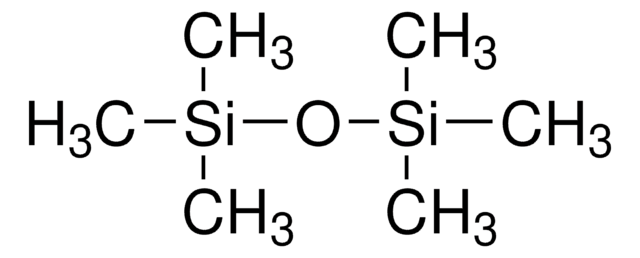87920
Tetramethylsilane
analytical standard, for NMR spectroscopy, ACS reagent
About This Item
Polecane produkty
klasa czystości
ACS reagent
analytical standard
for NMR spectroscopy
Poziom jakości
ciśnienie pary
11.66 psi ( 20 °C)
Próba
≥99.5% (GC)
Postać
liquid
temp. samozapłonu
842 °F
współczynnik refrakcji
n20/D 1.358 (lit.)
n20/D 1.359
tw
26-28 °C (lit.)
mp
−99 °C (lit.)
gęstość
0.648 g/mL at 25 °C (lit.)
Zastosowanie
environmental
format
neat
temp. przechowywania
2-8°C
ciąg SMILES
C[Si](C)(C)C
InChI
1S/C4H12Si/c1-5(2,3)4/h1-4H3
Klucz InChI
CZDYPVPMEAXLPK-UHFFFAOYSA-N
Szukasz podobnych produktów? Odwiedź Przewodnik dotyczący porównywania produktów
Opis ogólny
Zastosowanie
Hasło ostrzegawcze
Danger
Zwroty wskazujące rodzaj zagrożenia
Zwroty wskazujące środki ostrożności
Klasyfikacja zagrożeń
Flam. Liq. 1
Kod klasy składowania
3 - Flammable liquids
Klasa zagrożenia wodnego (WGK)
WGK 3
Temperatura zapłonu (°F)
-16.6 °F - closed cup
Temperatura zapłonu (°C)
-27 °C - closed cup
Środki ochrony indywidualnej
Eyeshields, Faceshields, Gloves
Choose from one of the most recent versions:
Masz już ten produkt?
Dokumenty związane z niedawno zakupionymi produktami zostały zamieszczone w Bibliotece dokumentów.
Klienci oglądali również te produkty
Nasz zespół naukowców ma doświadczenie we wszystkich obszarach badań, w tym w naukach przyrodniczych, materiałoznawstwie, syntezie chemicznej, chromatografii, analityce i wielu innych dziedzinach.
Skontaktuj się z zespołem ds. pomocy technicznej







